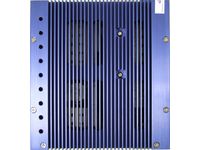Silent PSUs: Fortron Versus Silverstone
Fortron/FSP Zen 400
The Zen 400 from Fortron, with its output of 400 watts, stands out immediately thanks to its blue color. Compared to its 300 watt predecessor, the first thing you notice is a large aluminum cooling element on the underside of the unit, which is reflected in its considerably higher weight.


There is a single 6-pin connection for graphics cards. The ATX connection corresponds to the ATX12V 2.2 standard; it has 24 pins and can be split to accommodate older motherboards.
The unit’s connections are no longer up-to-date. It only has four SATA connections, yet these are becoming more and more important. Oddly, there are still six of the 4-pin Molex connections used by older drives. There are also two floppy connections on the power supply, though these can be used for fan controllers. The +12V CPU connection is only available as 4-pin version, which can lead to problems with some boards that require an 8-pin connection.
The length of the connection cables also leaves a lot to be desired: only 16” (40 cm) to the ATX connection. This may be too short for larger cases, and as a result, it may not be possible to route the cables as neatly as one would like.
Get Tom's Hardware's best news and in-depth reviews, straight to your inbox.
Current page: Fortron/FSP Zen 400
Prev Page Passive Power Supplies In The Lab Next Page Fortron/FSP Zen 400 (Continued)-
knowom I think they'd be great for a digital audio workstation environment now if only there was some more competition in this market segment to drive prices down to a more decent level.Reply -
mdmadph "The +12V CPU connection is only available as 4-pin version, which can lead to problems with some boards that require an 8-pin connection."Reply
Know of many HTPC boards that need an 8-pin CPU connection? :\ I sure don't. -
I have read 3-4 other reviews of the zen 400W, and I'm pretty sure there has been no mention of the high pitched sound. It's not a good sign for the zen, but it's probably a faulty powersupply tested in this review.Reply
-
gwolfman Ummmm, so where's the temps? The review is practically pointless without temp measurements on a fanless PSU. BOOOOO!Reply -
jeffunit Without specifying the input voltage, efficiency measurements are pretty useless. Running at 240v will yield a few percent higher efficiency than 120. Even 240v will be more efficient than 220v.Reply -
kittle Re-run your review and include tempratures. Its pointless w/o them.Reply
If you have found a fanless PSU thats safe to touch -- thats great. but if these things get to 40, 50, 60c - then we need to know not to buy them. -
I own the Zen400 power supply and it's exactly what I needed for a quiet HTPC, to the point where it's literally impossible to tell when the PC is on. During normal operation I have never heard the high pitched sound this review mentions (although it did output a sound similar in volume and annoyance to a smoke alarm when I failed to plug in the power cable to the graphics card - it was clearly an error/failure tone).Reply
-
In regards to the lack of the 8 pin CPU 12v connector, if you can find a motherboard of which the 4 +12v pins of the port are not electrically connected, please point it out to actually justify needing the 8 pin connector. To be honest, a motherboard with a single +12v pin isolated to only 1 or 2 vcore phases would'nt be any motherboard you would want to purchase, for power efficiency reasons.Reply
-
Alternator I agree with the above posters, temps would be nice, and not just of the PSU...Reply
I am quite interested in getting a capable (above 400watt) PSU that doesn't require a fan, but I really need to keep an eye on the temperatures.
I have a fanless mb and vid card (3850 radeon), and would wonder if adding a fanless psu into the mix would jeopardise the system by reducing the air flow through the case. (after all I wouldn't get a fanless PSU if my other components were noisy to begin with!?)
Perhaps an article focused more on configuring a quiet computer (for the purpose of gaming) could be in order?